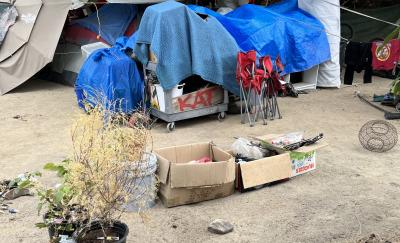Finding A Home for Mental Health



It was late on a Saturday afternoon in the heart of Chapel Hill, N.C.. The University of North Carolina basketball team had won a big game, and the streets were awash in Tar Heel blue, giddy fans tripping and galloping in all directions. Walking along the street, caught up in the whirl of activity, I turned a corner and saw a young man sitting alone beside a trash bag. He was overdressed for the sunny day, with two coats, heavy pants and combat boots. He huddled over something, clearly concentrating and clearly frustrated. Tentatively, I sat down on the curb and asked, “Do you need help with something?” He slowly turned toward me and extended his arm, then turned his palm upward. In his hand, he clutched a brand new phone— trapped inside its clamshell packaging.
Over the next hour, I came to learn that this young man (I’ll call him Vincent) was from Arizona, where his mother still lived. Vincent wanted to go home. Earlier, he had asked to use someone’s phone, and they had walked into the Target nearby and purchased him a pre-paid phone. After using my own phone to interpret the complex activation instructions, moving to a free Wi-Fi spot and after several failed attempts, Vincent had a working device. I was elated that I had succeeded in this small task, and we called his mom. After a few minutes, during which Vincent said very little, he handed the phone to me without explanation. Vincent’s mom sounded very far away, very tired, and very sad. She confirmed what I had guessed: Vincent had schizophrenia and often didn’t take his medication. “He wants to come home,” she said, but she didn’t know how that would work. I wondered: Did she mean how would he manage to get on a plane and fly? Or did she mean it wouldn’t “work” to have him return to her care? It didn’t really matter; Vincent had no money and no one to help facilitate that kind of cross-country trip. He was on his own.
May is Mental Health Awareness Month.


For 75 years, we have used this opportunity to educate the public about general mental health issues, reduce stigma, and support wellness, often by advocating for better policies and encouraging people to seek help.
The 1949 North Carolina version of Vincent – a young adult with schizophrenia--would likely have lived at Dorothea Dix, the state hospital, rather than on the street. While homelessness existed, a coordinated federal response was still several decades in the future. Meanwhile, the flood of returning WWII Veterans with significant mental health needs—and a gradual shift toward deinstitutionalization, among other factors—pushed mental illness and mental health into the spotlight. It is not a coincidence that April 1949 is also the year that the National Institute of Mental Health was established. Advocacy efforts of the national organization Mental Health of America, among others, were simultaneously focused on reducing stigma through improved public awareness as well as improving research and training to better support the treatment of mental health conditions.
Improving Data Collection and Building Best Practices


Fast forward to 2024. While most people experiencing homelessness in the United States do not have serious mental illness, we still try to estimate the number of people who are experiencing both homelessness and mental illness through different mechanisms. Just how many people are there who fit into this category? The answer, not surprisingly, is difficult to pin down. The National Survey on Drug Use and Health (NSDUH) focuses on the civilian, noninstitutionalized population of the United States. As a result, people experiencing unsheltered homelessness are not typically included in the survey's coverage. From the housing side, the Housing and Urban Development’s (HUD) Annual Homelessness Assessment Report (AHAR) does collect information about the presence of mental illness as part of their annual survey, called the Point in Time Count (PIT). However, these questions are optional, and HUD allows communities to use different wording and questions to suit local needs and contexts. Abt’s Dr. Meghan Henry, who leads the production of the AHAR, explains, “For a number of reasons, these data are not reliable to capture the full extent of serious mental health issues among people experiencing homelessness. Beyond the variability in how and whether the data are collected in communities, this is personal health information that most people would not share with strangers.” The PIT question here, in the county where Vincent lives is, “Have you been diagnosed with any of the following conditions?” I imagine that Vincent’s understanding of what that question is even asking would largely depend on whether he was on or off his medication. How he would answer is a different question.
Counting is critical, since it allows organizations to receive funding to provide services to address the significant needs of this population. But what actually helps? In 2023, Abt reviewed published literature to develop a resource called Expanding Access to and Use of Behavioral Health Services for People Experiencing Homelessness. The guide identifies several approaches, including intensive case management, peer support, motivational interviewing, and the critically important practice of meeting people like Vincent where they are – both physically and psychologically. In my own community, the a street outreach program connects people experiencing homelessness with housing and services. The program uses a relationship-based model to provide ongoing engagement and case management for people who are unsheltered. Next door in Durham, Urban Ministries serves three meals a day, seven days a week, 365 days a year, absolutely free. Abt staff support this work through regular breakfast shifts, working alongside peers and other staff. Programs like SOHRAD and Urban Ministries often find that peers are better able to bridge the gulf between professional knowledge and the lived reality of those on the streets.
The Power of Supportive Housing


Once a peer or other professional establishes a connection, what are the best options for young adults like Vincent? According to Abt’s State and Local Housing lead and supportive housing expert Katie Kitchin: “Supportive Housing has been found time and again to be a very effective intervention for individuals like Vincent. It combines the safety and security of affordable housing with the intensive supports that people need to stay connected to health care, employment, and community. It is the alternative to institutionalization that was promised but has never been fully realized across the country.” Many states recognize the importance of this level of care and are increasing their investment in these services. For example, Abt recently completed an analysis for the Colorado Department of Health Services to help identify pathways to behavioral health care for individuals with mental illness and are at risk during community transitions. A key question was, “How do we prevent people from leaving jails and prisons and ending up back on the street? And how do we prevent people who are experiencing homelessness from ending up back in jails and prisons?” We found that, regardless of their background (e.g., representing housing, behavioral health or the justice system), respondents universally talked about the need for more supportive housing. Colorado is well on its way. In the past decade, the Colorado Office of Homeless Initiatives has created 2500-plus project-based supportive housing opportunities across 65-plus developments, although the need remains significant.
A few days after I met Vincent, I called his new phone. He did not answer, and our paths have not crossed again. I think of him whenever I walk past the place we met, and I think about the vast unmet needs: for accurate data, for more services, and for well-researched, evidence-based, solutions to support the many Vincents living at the nexus of homelessness and mental illness.
Read More
Housing, Communities & Asset Building in North America

Shelter from the Storm: Addressing the Dual Crisis of Extreme Weather and Homelessness
Homeless response systems need support to strengthen their resilience to extreme weather shocks and the disproportionate harm that extreme weather has on people experiencing homelessness.

Understanding Homeless Encampments in Long Beach, L.A. River Basin, and San Fernando Valley
A Conrad N. Hilton Foundation-funded, Abt-led evaluation studied three encampments in Los Angeles.

Rental Housing Results from Low-Income Housing Tax Credits
Abt is merging databases with information on rental housing results from low-income housing tax credits to inform decision-making.

Wyoming Turns to Abt to Create Statewide Housing Plan
The State of Wyoming has turned to Abt Global to help it rapidly and effectively address its housing shortage by creating a statewide action plan.